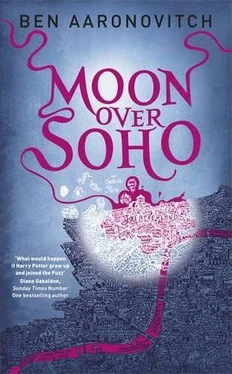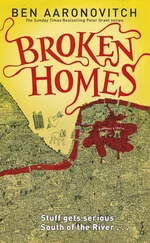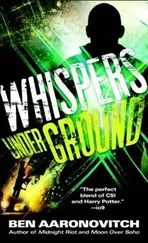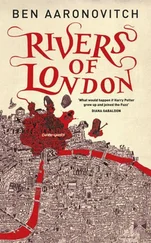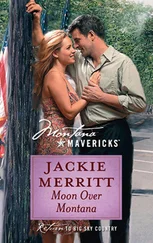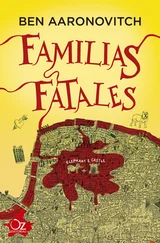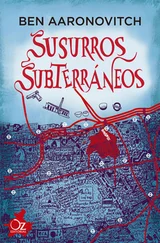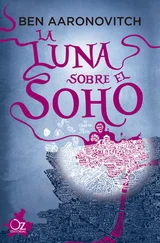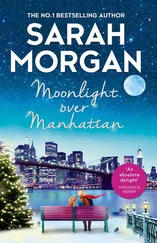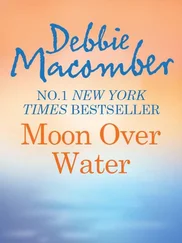THE FOLLY, according to Nightingale, is protected by an interlocking series of magical protections. They were last renewed in 1940 to allow the post office to run in a then-cutting-edge coaxial telephone cable to the main building and the installation of a modern switchboard. I’d found that under a dust sheet in an alcove off the main entrance lobby, a beautiful glass-and-mahogany cabinet with brass fittings kept shiny by Molly’s obsessive need to polish.
Nightingale says that these protections are vital, although he won’t say why, and adds that he, acting on his own, is not capable of renewing them. Running a broadband cable into the building was out of the question and it looked for a while like I was going to be firmly mired in the Dark Ages.
Fortunately, the Folly had been built in the Regency-style when it had become fashionable to build a separate mews at the back of a grand house, so that the horses and the smellier servants could be housed downwind of their masters. This meant a coach house at the back, now used as a garage, and above that an attic conversion that had once housed servants and later served as a party space for the young bucks back when the Folly had young bucks. Or at least more than one. The magical “protections” — Nightingale was not happy when I called them “force fields” — used to scare the horses, so they don’t extend to the coach house. Which means I get to run in a broadband cable, and at last there is a corner of the Folly that is forever in the twenty-first century.
The coach house attic has a studio skylight at one end, an Ottoman couch, a chaise longue, a plasma TV, and an IKEA kitchen table that once took me and Molly three bloody hours to assemble. I’d used the Folly’s status as an Operational Command Unit to get the Directorate of Information to cough up half a dozen airwave handsets with charging rack and a dedicated HOLMES 2 terminal. I also had my laptop and my backup laptop and my PlayStation — which I hadn’t had a chance to get out of the box yet. Because of this there is a big sign on the front door that says NO MAGIC ON PAIN OF PAIN. This is what I call the tech-cave.
The first thing I got when I booted up was an email from Leslie with the header Bored! so I sent her Dr. Walid’s autopsy report to keep her occupied. Then I opened up Police National Computer Xpress and ran a DVLA check on Melinda Abbot’s license plate and found that the listed information matched that on her driver’s license. I ran Simone Fitzwilliam as well, but evidently she’d never applied for a license or owned a car. Nor had she committed, been the victim of, or reported a crime within the United Kingdom. Or possibly all that information had been lost, inaccurately entered into the databases, or she’d just changed her name recently. Information technology only gets you so far, which is why coppers still go around knocking on doors and writing things down in little black notebooks. I Googled them both for good measure. Melinda Abbot had a Facebook page as did a couple of people with the same name, but Simone Fitzwilliam had no obvious Internet presence at all.
I worked my way through Dr. Walid’s list of dead jazz musicians — all men, I noticed — in much the same way. They’re always doing clever cross-referencing stuff on the TV, and it’s all perfectly possible, but what they never show is how sodding long it takes. It was pushing midnight by the time I got to the end of the list and I still wasn’t sure what I was looking at.
I took a Red Stripe from the fridge, opened the can, and had a swig.
Definite fact number one: Each year for the last five, two or three jazz musicians had died within twenty-four hours of playing a gig in the Greater London area. In each case the coroner had ruled the death either “accidental” by way of substance abuse or by natural causes — mostly heart attacks with a couple of aneurysms thrown in for a bit of variety.
Dr. Walid had included a supplemental file recording every person who’d listed their profession as musician and had died over the same period. Definite fact number two: While other musicians dropped dead from “natural causes” with depressing frequency, they didn’t seem to regularly die just after gigs the way the jazzmen did.
Definite fact number three: Cyrus Wilkinson hadn’t even listed his occupation as musician but as an accountant. You never claim to be a freelance or artistic anything unless you want a personal credit rating lower than an Icelandic bank’s. Which led to definite fact number four: My statistical analysis was pretty much worthless.
And yet three jazz musicians a year — I didn’t believe it was a coincidence.
But Nightingale wasn’t going to go for anything that flimsy. And he was still going to expect me to perfect scindere starting the next morning. I shut everything down and turned it all off at the plugs. That’s good for the environment and more important stops all my expensive gear from getting randomly fried by a surge in magic.
I let myself into the Folly through the kitchen. The waning moon lit the atrium through the skylight so I left the lights off as I climbed the stairs to my floor. On the balcony opposite I glimpsed a pale figure silently gliding among the muffled shadows of the west reading room. It was just Molly, restlessly doing whatever it is she restlessly does at night. When I reached my landing the musty carpet smell told me that Toby had once again fallen asleep against my door. The little dog lay on his back, his thin ribs rising and falling under his fur. He snuffled and kicked in his sleep, hind legs pawing the air, indicating at least five hundred milliyaps of background magic. I let myself into my bedroom and carefully closed the door so as not to wake him.
I climbed into bed and before I turned out the side lamp I texted Leslie — WTF DO NOW?
The next morning I got a text back. It read: GO TLK BAND — IDIOT!
Chapter 3
A Long Drink of the Blues
THE BAND weren’t that hard to find — the Spice of Life had their contact details and they all agreed to meet me at French House on Dean Street, but it had to be in the evening because they all had day jobs. That suited me because I was still behind on my Latin vocab. I trolled over to Soho just after six and found them all waiting for me, propping up a wall peppered with pictures of people who had been famous just at the time my dad hadn’t.
The Spice of Life playbill listed my lot as the Better Quartet, but they didn’t really look much like jazzmen to me. Bassists are famously steady but Max — really Derek — Harwood was an average-looking white guy in his mid-thirties. He was even wearing a diamond-patterned Marks & Spencer V-neck sweater under his jacket.
“We already had a Derek in the band before last,” said Max. “So I went by Max to avoid confusion.” He took a subdued sip from his beer. I’d bought the first round and was feeling suitably gouged. Max was an integrated systems specialist for the London Underground — something to do with signaling systems, apparently.
The pianist, Daniel Hossack, was a classically trained music teacher at Westminster School for the terminally privileged. He had receding blond hair, round Trotsky glasses, and the sort of sensible kindness that probably led to him being savagely lampooned by the spotty wits of the lower sixth — that’s year 12 in the new money.
“How did you guys meet?” I asked.
“I don’t think we met as such,” said James Lochrane, the drummer. Short, Scottish, belligerent, and taught seventeenth-century French history at Queen Mary’s College. “It would be more accurate to say that we coalesced — about two years ago …”
“More like three,” said Max. “At the Selkirk Pub. They have jazz on Sunday afternoons. Cy lives down there so it’s sort of his local.”
Читать дальше
